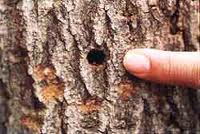As if the Ohio invasion of the Emerald Ash Borer wasn’t enough, the Asian Longhorned Beetle may be the next critter to endanger Ohio forests. As the name indicates, this destructive invasive is from east Asian countries and has apparently been hitch-hiking across the U.S. in shipping crates and pallets. Already, eradication efforts are underway in Massachusetts, New Jersey, and New York and it appears to have been successfully eradicated in Chicago. While the Emerald Ash Borer’s tree-du-jour are ash trees, the ALB grows, reproduces in, and kills deciduous hardwood trees such as ALL types of maples (sugar, silver, red, Norway and box elder), birches, horse chestnuts, poplars, willows, elms, ashes (Those poor ash trees can’t cut a break!) AND even our buckeyes!
 On June 9, an alert landowner noticed three damaged maple trees on his property a few miles from the Village of Bethel in Tate Township, Clermont County, east of Cincinnati, OH. On Friday, June 17, 2011, the United States Department of Agriculture, Animal and Plant Health Inspection Service (USDA APHIS) and the Ohio Department of Agriculture (ODA) confirmed that an Asian Longhorned Beetle (Anoplophora glabripennis) (ALB) infestation was found. Consequently, Ohio Governor Kasich signed an Executive Order restricting the movement of hardwood logs, firewood, stumps, roots, and branches out of Tate Township. This is the first ALB infestation found in Ohio. USDA APHIS has responded with personnel on the scene to assess the extent of the infestation and to develop and implement a management plan.
On June 9, an alert landowner noticed three damaged maple trees on his property a few miles from the Village of Bethel in Tate Township, Clermont County, east of Cincinnati, OH. On Friday, June 17, 2011, the United States Department of Agriculture, Animal and Plant Health Inspection Service (USDA APHIS) and the Ohio Department of Agriculture (ODA) confirmed that an Asian Longhorned Beetle (Anoplophora glabripennis) (ALB) infestation was found. Consequently, Ohio Governor Kasich signed an Executive Order restricting the movement of hardwood logs, firewood, stumps, roots, and branches out of Tate Township. This is the first ALB infestation found in Ohio. USDA APHIS has responded with personnel on the scene to assess the extent of the infestation and to develop and implement a management plan.
Let me introduce you to this new pest: ALB have bodies about an inch long, are shiny black and have bright white spots. Each adult has a pair of curved, black-and-white striped antennae that are even longer than the body. Adults emerge from trees during May, June and July. They feed on plant shoots for a few days and then mate. After mating, females chew roughly oval pits in the bark of host trees, where they lay eggs. When the eggs hatch, the white grub-like larvae bore into the wood. Larvae mature inside the tree until they become adults and chew round, 3/8 inch (nearly dime-sized) exit holes in trunks and branches, from which they emerge. This life cycle produces new adults every year, rather than every 2-4 years like most other longhorned beetles. The ALB can fly hundreds of feet, perhaps farther when assisted by the wind.
What can you do if you think you’ve found one of these? Obviously, you would want to capture a specimen to be sure. A special toll-free telephone number has been established by the ODA for Ohioans to report suspected ALB infestations or suspiciously large black and white beetles with really long black-and-white striped antennae. The number is: 855-252-6450. The USDA APHIS has several YouTube videos that may also help in your CSI work. Check them out HERE.
Sales alert
Ever’s Country Gardens, a fifth generation family-owned and operated grower north of Lebanon, OH, has all of their annuals and perennials on sale for 50% off. Trees and shrubs are 25% off. They are located just north of the St. Rt. 48 bypass at: 1815 U.S. 42 north, Lebanon, OH, 45036. Phone: 513-932-3914.
I found figs
I was down at Jungle Jim’s International Food Market in Fairfield, OH yesterday and they had hundreds (yes, hundreds) of brown Turkey figs for sale in about a 2 gallon pots. They were about three feet tall and many had figs. The prices were $24.99, down from $29.99. If you have never visited Jungle Jim’s – it’s a hoot. I came home with foods from Greece, Macedonia, Italy and closer to home: Durango, Colorado. The fresh peaches from South Carolina are scrumptious!


